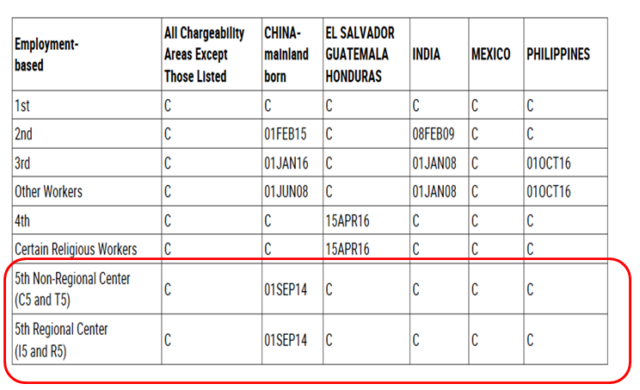Each month, the Department of State (DOS) issues a visa bulletin which contains information regarding the availability of immigrant visas. The availability of immigrant visas is subject to numerical caps imposed by Congress, which limit how many foreign nationals may obtain immigrant visas each year. In the employment-based green card category Congress allots 140,000 immigrant visas (green cards) to be issued annually. The employment-based categories are subdivided into five preference categories:
-
EB-1: Priority Workers (Extraordinary Ability, Outstanding Professors and Researchers, and Multinational Managers or Executives)
-
EB-2: Professionals Holding Advanced Degrees and Persons of Exceptional Ability
-
EB-3: Skilled Workers, Professionals, and Unskilled Workers
-
EB-4: Certain Special Immigrants including Religious Workers
-
EB-5: Immigrant Investors
No one country in each of the five categories is allowed to exceed more than 7 percent of the category per the requirement of 8 U.S. Code § 1153.
The employment-based fifth preference category “EB-5” is allotted approximately 10,000 immigrant visas annually. This quota includes principal applicants, as well as spouses and dependent children under 21 years of age. The visas are issued from Oct. 1 (the first date of the government’s fiscal year) until Sept. 30. On Oct. 1 of each year, the quota of visas is reset.
Sometimes, in order to deal with these numerical limits and when the annual quota is exhausted in a particular fiscal year, sometimes DOS has to establish a wait line that determines the order in which immigrant visas are issued. This wait line is referred to as “retrogression.” The DOS uses an applicant’s “priority date” to determine when an applicant can apply for an immigrant visa or file an adjustment of status application in the U.S. An applicant’s priority date is based upon the day their I-526 petition was received by the United States Citizenship and Immigration Service (USCIS). As you can see from the below example, the priority date is listed on the top of an investor’s I-526 approval notice.
In this example, our applicant has a priority date of 1/30/2017. The applicant then must check the DOS visa bulletin to find out if his or her priority date is current. If the visa bulletin lists the priority date as current, represented by a letter “C”, then the applicant can apply for a green card either through immigrant visa Consular Processing at the U.S. Embassy in their home country or through the filing of an I-485 Application for Adjustment of Status with the USCIS in the United States upon the approval of their I-526 petition. An applicant who applies for the green card in the United States through Adjustment of Status must be in valid non-immigrant visa status to do so. As part of the Adjustment of Status filing, the U.S. based applicant, as well as their dependent applicants, are entitled to receive work authorization through the issuance of an Employment Authorization Document (EAD), as well as travel authorization known as Advance Parole (AP).
APRIL 2018 Visa Bulletin
In addition to checking if a category is current, the applicant must also ensure that they are not born in a country which has exceeded the 7 percent allotment for immigrant visas for the particular fiscal year. If their country of birth is a country that has exceeded its yearly allotment then a wait line for filing a green card application develops, known as retrogression. When retrogression of priority dates occurs, then it is important for an applicant to check to see if they can file their green card application after their EB-5 petition is approved by checking the visa bulletin on a monthly basis. If a date is listed on the visa bulletin, an applicant can only file their application if their priority date is on or before the date listed on the visa bulletin. If the priority date is later than the date listed on the visa bulletin, the applicant will have to check back the following month when the DOS issues its next visa bulletin to see if their priority date has become current (i.e. if the applicant’s priority date is now earlier than the date listed on the visa bulletin). The dates in the visa bulletin will either move forward, back, or stay stagnant. Such changes will be reported monthly. These movements in the visa bulletin are based on the number of green card applications received during the previous month and the available spots remaining in the category. Likewise, sometimes the category can move forward if the other EB categories are underutilized because DOS then reallocates their numbers to the categories with backlogs. For example, if the EB-1 category is not used, EB-5 may benefit from a partial reallocation of the unused immigrant visa numbers.
At present, the EB-5 visa category is current for nationals of all countries with the exception of China. However, the DOS has informed EB-5 stakeholders that they expect the priority dates to retrogress for Vietnamese nationals, imminently. Using the approval notice above and a sample visa bulletin based on this information pasted below, we have created a sample visa bulletin for an applicant born in Vietnam with an EB-5 priority date of 1/30/2017. Based on our example below, the applicant will not be able to file their green card application because the EB-5 category in our example is not current except for applicants who filed their applications on or before Jan. 1, 2017.
SAMPLE VISA BULLETIN FOR MAY 2018
Likewise, if the total number of visas has been used up in a particular year in a particular category, the visa bulletin will note that the category is unavailable, which is represented by a “U”. This can occur when the DOS determines no more immigrant visas can be issued at the present time.
While Vietnam’s immigrant visa processing is expected to retrogress along with the processing for the other, already retrogressed country Mainland China, other countries using the EB-5 visa will stay current, and will be able to proceed with their green card applications upon I-526 petition approval. Likewise, if an investor born in a country subject to a backlog is applying with their spouse who was in fact born in a country not subject to retrogression, the investor and their children can avoid the backlog by “charging” their green card processes to the country of birth of the spouse. This would enable them proceed with the green card application immediately upon the approval of the I-526 petition.
Those planning to apply for a green card from within the U.S., while still subject to retrogression, may be able to avail themselves of an earlier priority date established specifically for the filing of adjustment of status applications. It can be found in the monthly visa bulletin in Chart B, and USCIS provides monthly updates as to whether they allow the reliance on Chart B for this purpose. Finally, once the adjustment of status is filed, applicants can continue to remain in the U.S. for the duration of the application pendency as “Adjustment of Status” applicants without maintaining an underlying non-immigrant visa status. They will also be able to annually renew their EAD and AP to permit them to work and travel until their green card applications are adjudicated. If there is a movement in priority dates, they will have their petition already in queue for adjudication.
In the event of retrogression, NVC will hold the applications until the priority dates become current. Depending on the length of time the I-526 petition is pending and the extent of the backlog, children close to the age of 21 may lose their ability to derive from their parent’s application. In this case, they may need to apply for the EB-5 immigrant investor visa on their own or seek an alternative path toward U.S. immigration. Individuals with this concern should speak to an attorney. Likewise, individuals who spend a year or more in retrogression may also need to supplement their application at the time that their application becomes current with updated documentation such as new police certificates and medical examinations. Those subject to the backlog should contact their attorney to discuss alternative non-immigrant visa options to allow them to come to the U.S. while their EB-5 based green card is in process.



 />i
/>i




